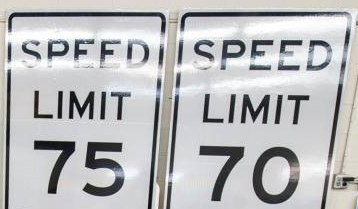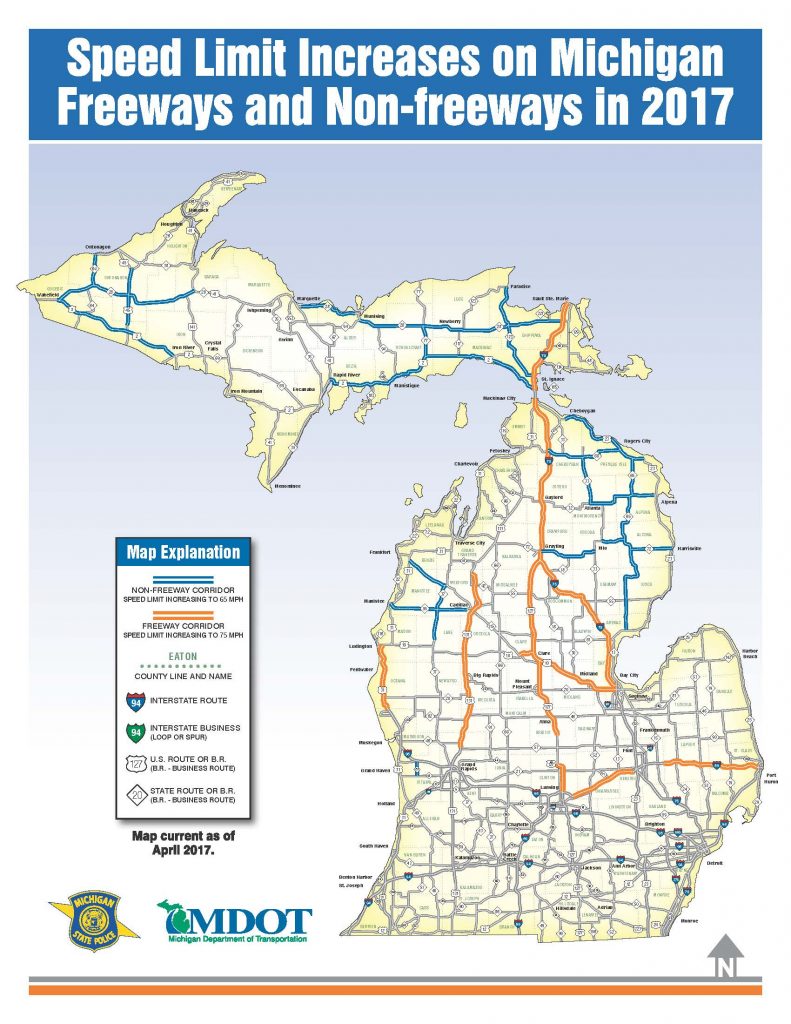Michigan Speed Limit Increase: Will Roads Become More Dangerous?

The speed limit on certain stretches of Michigan interstates is increasing to 75 mph, while it jumping to 65 mph on other state highways. This Michigan speed limit increase began taking effect gradually on May 1, 2017.
According to the Michigan Department of Transportation (MDOT), the speed limit on more than 600 miles of freeways is being boosted from 70 to 75 mph, while it going up to 65 mph on another 938 miles of state roadways. Speed limit signs started changing May 1, and the higher speed limit is official when the roads are actually signed.
The speed limit in the mid-Michigan area is increasing to 75 mph along several routes:
- an 18-mile stretch of US-127 from the I-69 intersection until St. Johns.
- a 33-mile stretch of I-69 starting at the intersection with East Saginaw Street in Bath Township and heading east into Genesee County.

Based on an MDOT map of the Michigan speed limit increase, the speed limit is not being raised on the highway around downtown Lansing or south of Lansing, including the I-496 and US-127 interchange and the I-94 and US-127 corridor in Jackson. This is good news because both of these areas have been designated by the Sinas Dramis Law Firm as Michigan dangerous roads, due to the high rate of auto accidents.
Why is there a Michigan speed limit increase? Because last year, the state Legislature passed a law instructing MDOT and the Michigan State Police (MSP) to consider raising the speed on freeways and highways across the state.
After an analysis and review, MDOT and the MSP have decided it is now time to boost the speed limits on certain roadways.
Michigan Speed Limit Increase: Locations And Limits
According to MDOT, the following stretches of freeway are jumping from 70 to 75 mph for most vehicles. The speed limit for large trucks, including semi-trucks, is increasing from 60 to 65 mph.
- I-75: Bay City to US-23 in Mackinaw City (Bay, Arenac, Ogemaw, Roscommon, Crawford, Otsego, Cheboygan, and Emmet counties), and St. Ignace to Sault Ste. Marie (Mackinac and Chippewa counties)
- US-127: I-69 to the end of the freeway at St. Johns (Clinton County) and the beginning of the freeway at Ithaca to I-75 (Gratiot, Isabella, Clare, Roscommon and Crawford counties)
- US-131: M-57 to the end of the freeway north of Manton (Kent, Montcalm, Mecosta, Osceola and Wexford counties)
- I-69: I-69 Business Route (Saginaw Highway) to Swartz Creek (Clinton, Shiawassee and Genesee counties)
- I-69: From the Genesee-Lapeer county line to I-94 (Genesee, Lapeer and St. Clair counties)
- US-10: M-115 to I-75 (Clare, Isabella, Midland and Bay counties)
- US-31: South Oceana County line to US-10 (Oceana and Mason counties)
As for state routes, the speed limit will increase to 65 mph in the following areas.
- US-2: Wakefield to Iron River (Gogebic and Iron counties)
- US-2: St. Ignace to Rapid River (Mackinac, Schoolcraft, and Delta counties)
- US-23: East of Cheboygan to east of M-65 (Cheboygan and Presque Isle counties)
- US-45: North of US-2 to M-26 (Gogebic and Ontonagon counties)
- M-28: East of Harvey to Christmas (Marquette and Alger counties)
- M-28: Munising to I-75 (Alger, Schoolcraft, Luce, and Chippewa counties)
- M-28: Wakefield to US-41 (Gogebic, Ontonagon, Houghton, and Baraga counties)
- M-32: Atlanta to Alpena (Montmorency and Alpena counties)
- M-33: Atlanta to Onaway (Montmorency and Presque Isle counties)
- M-37: Mesick to Wolf Lake (Wexford and Lake counties)
- M-55: US-31 to Cadillac West (Manistee and Wexford counties)
- M-64: M-28 to Old M-107 (Ontonagon County)
- M-65: US-23 to M-32 west junction (Arenac, Iosco, Alcona, and Alpena counties)
- M-65: M-32 east junction to US-23 (Alpena and Presque Isle counties)
- M-68: I-75 to US-23 (Cheboygan and Presque Isle counties)
- M-72: Grayling to Mio (Crawford and Oscoda counties)
- M-72: Fairview to M-65 north junction (Oscoda and Alcona counties)
- M-72: M-65 south junction to Harrisville (Alcona County)
- M-77: US-2 to M-28 (Schoolcraft County)
- M-115: Benzonia to Mesick (Benzie and Wexford counties)
- M-123: I-75 to Paradise (Mackinac and Chippewa counties)
- M-231: M-45 to M-104 (Ottawa County)
Will The Michigan Speed Limit Increase Lead To More Crashes?
Both MDOT and MSP have said the highways seeing a Michigan speed limit increase were chosen based on several factors:
- design.
- existing safety features.
- most motorists are already driving at the increased speed on these roadways.
It may be true that drivers have routinely been traveling at the higher speed along the selected Michigan highways. However, the question now becomes whether the Michigan speed limit increase on these roads will make them more dangerous, leading to more Michigan car accidents, serious injuries and fatalities.
While we do not yet know the answer to this question, research has been conducted in recent years on speed limit increases and the impact on auto accident rates. In 2016, a speed limit increase study performed by the Insurance Institute for Highway Safety (IIHS) found that boosting maximum speed limits has led to more deadly car accidents across the United States.
The IIHS study examined the effect of maximum speed limit increases in 41 states from 1993-2013, and looked specifically at traffic deaths per billion miles traveled by the type of road and the state. The study revealed that every 5 mph maximum speed limit increase caused a 4% increase in the fatality rate. On freeways and interstates — the roads that most often see speed limit increases — the study showed the fatality rate jumped 8%.
By comparing states’ annual fatalities to the total expected if maximum speed limits were not raised, the IIHS study concluded there were about 33,000 fatalities during the 20-year period that could be directly attributed to speed limit increases. According to IIHS, this is probably a low estimate because the study considered only increases in the maximum speed limit, which often applies to rural interstates and many states have also increased speed limits on urban interstates.
As a law firm that primarily handles Michigan no-fault claims and lawsuits involving damages for car accident injuries, Sinas Dramis is concerned about the decision to increase the speed limit on certain Michigan roadways. However, with that said, we encourage all Michigan motorists to drive safely and abide by the new speed limits.
In this video, Grand Rapids auto accident attorney Tom Sinas talks about the decision to increase the speed limit on certain Michigan roads.
[button url=”https://sinasdramis.com/contact-sinas-dramis-law-firm” target=”” size=”small” style=”politicalblue” icon=”” popup=”” title=””]Free Consultation[/button]

